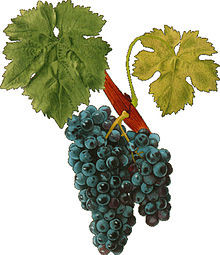Mazuelo
| Carignan | |
|---|---|
| Grape (Vitis) | |

Carignan in Viala & Vermorel
|
|
| Color of berry skin | Noir |
| Also called | See list of synonyms |
| Origin | Cariñena, Aragon |
| Notable regions | Languedoc, Sardinia, Algeria and Catalonia |
| Notable wines | Historically Cariñena and Rioja but little used now |
| Hazards | Rot, powdery mildew, downy mildew and grape worms. Late budding and ripening |
Carignan (also known as Mazuelo, Bovale Grande, Cariñena, Samsó, and Carignane) is a red Spanish/French wine grape variety that is widely planted throughout the western Mediterranean and around the globe. Along with Aramon, it was once considered one of the main grapes responsible for France's wine lake and was a substantial producer in jug wine production in California's Central Valley.
Ampelographers believe that the grape likely originated in Cariñena, Aragon and was later transplanted to Sardinia, elsewhere in Italy, France, Algeria, and much of the New World. The variety was historically a component of Rioja's red wine blend. From Spain, it gained prominence in Algeria and fed that country's export production to France. Upon Algeria's independence in 1962, the French supply of Carignan wine was cut off and growers in Southern France began to plant the vine for their own production. The grape's prominence in France hit a high point in 1988 when it accounted for 167,000 hectares (410,000 acres) and was France's most widely planted grape variety. That year, in a drive to increase the overall quality of European wine and to reduce the growing wine lake phenomenon, the European Union started an aggressive vine pull scheme where vineyard owners were offered cash subsidies in exchange for pulling up their vines. Out of all the French wine varieties, Carignan was the most widely affected dropping by 2000 to 95,700 ha (236,000 acres) and being surpassed by Merlot as the most widely planted grape.
...
Wikipedia
